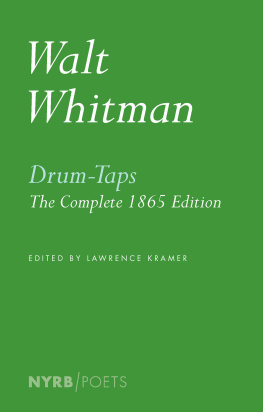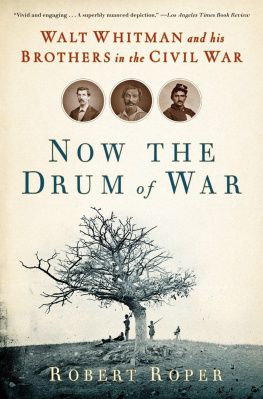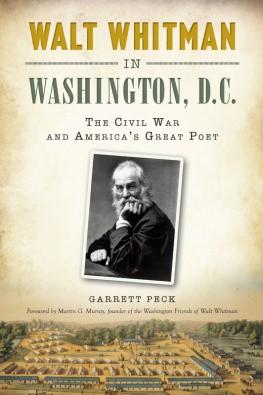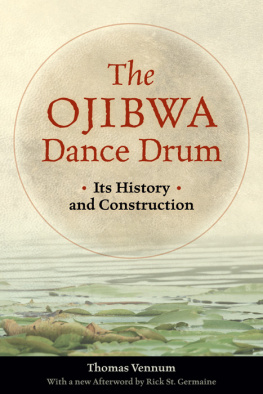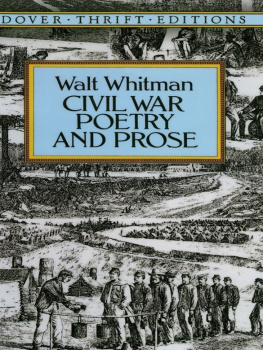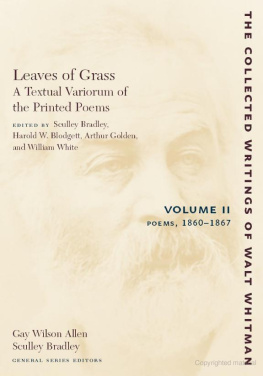WALT WHITMAN (18191892) revolutionized American poetry through the eleven editions of his magnum opus, Leaves of Grass, a celebration of the dynamism and diversity of a still-young America. Drum-Taps, first published in 1865, was written out of his experience as a nurse during the Civil War. It is a collection, he once wrote in a letter to a friend, put together by fits and starts, on the field, in the hospitals as I worked with the soldier boys.
LAWRENCE KRAMER is an author and composer who has often addressed Whitmans poetry in both capacities. He has set several of the poems from Drum-Taps to music and edited the essay collection Walt Whitman and Modern Music. Kramer is Distinguished Professor of English and Music at Fordham University.
Walt Whitman
Drum-Taps
The Complete 1865 Edition
EDITED, ANNOTATED, AND WITH AN INTRODUCTION BY LAWRENCE KRAMER


NEW YORK REVIEW BOOKS
New York
THIS IS A NEW YORK REVIEW BOOK
PUBLISHED BY THE NEW YORK REVIEW OF BOOKS
435 Hudson Street, New York, NY 10014
www.nyrb.com
Copyright 2015 by NYREV, Inc.
Introduction and notes copyright 2015 by Lawrence Kramer
All rights reserved.
Library of Congress Cataloging-in-Publication Data
Whitman, Walt, 18191892.
[Poems. Selections]
Drum-taps : the complete 1865 edition / by Walt Whitman ; edited, annotated, and with an introduction by Lawrence Kramer.
1 online resource. (New York Review Books poets)
Description based on print version record and CIP data provided by publisher; resource not viewed.
ISBN 978-1-59017-863-8 () ISBN 978-1-59017-862-1 (alk. paper)
I. Kramer, Lawrence, 1946- editor. II. Title.
PS3211.A2
811'.4dc23
2014047616
Cover design by Emily Singer
ISBN 978-1-59017-863-8
v1.0
For a complete list of books in the NYRB/Poets series, visit www.nyrb.com or write to:
Catalog Requests, NYRB, 435 Hudson Street, New York, NY 10014
Drum-Taps
(New York, 1865 )
Notes
Many of the texts quoted in the notes are readily available online; URLs are specified for sources that might otherwise require lengthy searches. All biblical quotations are given in the King James translation. Textual information comes from Walt Whitman, Leaves of Grass and Other Writings, edited by Michael Moon, Sculley Bradley, and Harold W. Blodgett (New York: Norton, 2002), and/or Walt Whitman, Leaves of Grass: A Textual Variorum of the Printed Poems, edited by Sculley Bradley, Harold W. Blodgett, Arthur Golden, and William White, 3 vols. (New York: New York University Press, 1980). A few secondary sources are quoted or cited in the notes, including David Reynolds, Walt Whitmans America: A Cultural Biography (New York: Vintage, 1996); James McPherson, Battle Cry of Freedom: The Civil War Era (New York: Oxford University Press, 1988); Drew Gilpin Faust, This Republic of Suffering: Death and the American Civil War (New York: Vintage, 2009); and Susan Dunn, Dominion of Memories: Jefferson, Madison, and the Decline of Virginia (New York: Basic Books, 2007).
INTRODUCTION
To William Douglas OConnor, January 6, 1865; quoted in Walt Whitman, Leaves of Grass and Other Writings, edited by Michael Moon, Sculley Bradley, and Harold W. Blodgett (New York: Norton, 2002), 785.
Ibid., 279. Whitman also made small textual changes through the successive editions, documented in Walt Whitman, Leaves of Grass: A Textual Variorum of the Printed Poems: Volume II: Poems, 18601867, edited by Sculley Bradley, Harold W. Blodgett, Arthur Golden, and William White (New York: New York University Press, 1980).
See Ted Genoways, The Disorder of Drum-Taps, Walt Whitman Quarterly Review 24 (Fall 2006), 98117.
See J. David Hacker, A Census-Based Count of the Civil War Dead, Civil War History 57 (2011), 30647.
Whitman, Leaves of Grass, edited by Moon, 785.
The quoted phrases are from Walt Whitman, Specimen Days, section 101, available at http://www.bartleby.com/229/1101.html.
DRUM-TAPS
The 1871 Leaves cuts this eponymous title and replaces it with the first line. In 1871 and 1876, an epigraph previewed the large-scale turn from bellicosity to mourning found in all versions of Drum-Taps. Whitman subsequently transferred the lines of the epigraph to The Dresser (later The Wound-Dresser): Aroused and angry, / I thought to beat the alarum, and urge relentless war, / But soon my fingers faild me, my face droopd, and I resignd myself / To sit by the wounded and soothe them, or silently watch the dead.
Tympanum: the drum or drumhead, but also the inner ear or tympanic membrane. The songs of Drum-Taps are to strike the ear as the city struck the drums.
The city is not modern New York, the five boroughs of which were not incorporated until 1898, but the island of Manhattan.
).
Whitman was a month shy of forty-two when the war broke out, but he first moved from his native Long Island to Manhattan in 1841.
As a woman warrior, the personified Manhattan merges with the Greek goddess Nike (Victory) and with the volumes recurrent figure of Liberty (Libertad); as the Lady of ships she is a ships figurehead come to life to lead her million children to war.
The Civil War began with the predawn bombardment of Fort Sumter in Charleston harbor, April 12, 1861; the fort fell to the Confederacy on April 14. News of the attack traveled the country by telegraph; Whitman learned of it around midnight on April 13 while returning home from a performance of Verdis Un ballo in maschera.
The stroke of Manhattans clenched fist on the pavement acts as the original drum-tap from which all others in the volume (and by extension the war) derive.
The beehive modeling harmonious community is a traditional image derived from Virgils Georgics (4:149227). Whitman inverts the trope: The news from the South shocks the hive, whose inhabitants pour forth buzzing with martial fury.
Whitmans account of Manhattans response to the outbreak of war is accurate but slightly misleading. Prior to Fort Sumter, New York City was a nursery of pro-southern sentiment (James McPherson, Battle Cry of Freedom: The Civil War Era [New York: Oxford University Press, 1988], 274); the response to the attack marked a startling turnaround registered in Whitmans shock electric. On April 15, Lincoln called for a militia of 75,000 men to quell the rebellion. On April 20, in the citys Union Square, 250,000 people gathered for what became known as the Great Sumter Rally, at the time the largest public gathering in the nations history.
Contemporary descriptions accord with Whitmans: Within a week of Fort Sumter, regiments of departing troops were parading down Broadway to cheering crowds, where thousands upon thousands lined the sidewalks; see Third Annual Report of the Bureau of Military Statistics of the State of New York (Albany: The Bureau, 1866).
The Civil War established nursing as a female profession in America, as the Crimean War (185356) had done in England. Male Civil War nurses nonetheless outnumbered women by four to one.
Mannahatta was the Lenape Indian name for Manhattan, meaning island of many hills, first recorded when Henry Hudson discovered the island in 1609. Whitman wrote two poems entitled Mannahatta, one in 1860 and one (much shorter) in 1888; both invoke the citys aboriginal name as a mark of grandeur. The shift here from Manhattan to Mannahatta elevates the effort to save the Union to a mythic-heroic work for giants in which artillery glitters like gold.
Next page
